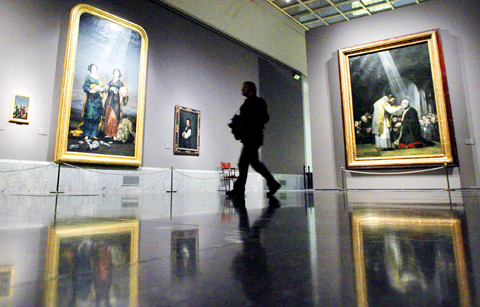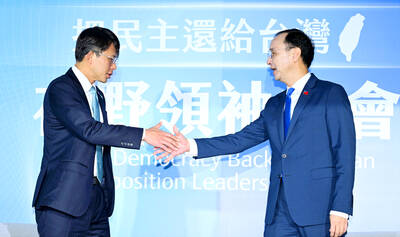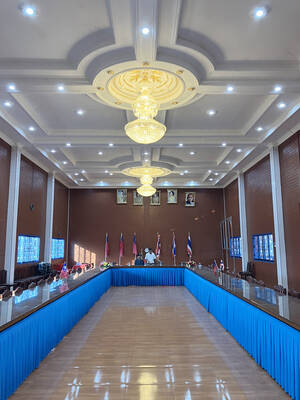It’s not an art show for the squeamish or faint-hearted.
In its main spring event, Spain’s Prado Museum unveiled an exhibition on Monday featuring some 200 paintings and drawings by Spanish master Francisco Jose de Goya y Lucientes, including many depicting in unnerving detail the horrors man is capable of unleashing.
“It’s an exhibition to be seen, but it’s not one to have a good time at,” said Jose Manuel Mantilla, the museum’s drawings and engravings chief. “One comes away from it distressed.” Titled Goya in Times of War, the exhibit includes 90 paintings and more than 100 drawings and engravings from a 25-year period that spanned the changeover from the 18th century to the 19th century.

PHOTO :EPA
The show is part of Spain’s 200th anniversary commemorations of the country’s war of independence following an invasion by Napoleon’s troops.
“Art ought to show beauty, but it should also make us reflect,” said Mantilla. “This show is a reflection on man’s violence, and it makes Goya universal and very contemporary.” The centerpiece of the exhibition features two large-scale masterworks, the second and third of May 1808 paintings, specially restored for the show. They depict a gruesome revolt against French forces in Madrid and the chilling reprisal by Napoleon’s troops the day after.
“It’s a disturbing exhibition that leaves little room for optimism,” said the show’s curator, Manuela Mena.
The show concentrates on Goya’s work after 1793, when a near-fatal illness left the artist deaf.
“He came out of the sickness renewed and started to painting differently. He was searching for independence and liberty,” she said.
During this time he evolves from official Spanish court painter to an independent artist blessed with a critical eye and an exceptional talent for realism, offering an intense insight into the nature of man.
In it, he alternates from exuberant portraits of royalty in all their finery — such as the family portrait of Carlos IV — to dozens of paperback-book-size drawings and etchings of Disasters of War, Bullfighting and Follies, series with ironic captions depicting the cruelty, stupidities and vices of Goya’s contemporaries.
Many of the works show scenes of bloody and torturous beatings and slayings, bodies piled up in heaps and people fleeing in terror.
The exhibit displays works from the troubled decades covering the French Revolution, the Napoleonic Wars and the ensuing treaties that brought an end to the Ancien Regime in France and ushered in modern Europe.
Organizers point out that in many ways Goya was a privileged witness, something of a pictorial war reporter. But he broke with a style fashionable up to his time of eulogizing war and instead highlighted its barbarity.
“It is the artistic diary of Goya in one of the most turbulent periods of Spanish history,” said Prado director Miguel Zugaza.
Although the Prado has the world’s largest collection of Goya, 75 percent of the show’s work comes from outside, many from private collections, such as Majas on the Balcony and Marquise of Montehermoso. For curator Mena, the show should help put an end to the myth that Goya was mad.
“The work we have before us could not come from a person not in possession of all his faculties,” she said. “The madness was not inside Goya, but outside him.”

May 26 to June 1 When the Qing Dynasty first took control over many parts of Taiwan in 1684, it roughly continued the Kingdom of Tungning’s administrative borders (see below), setting up one prefecture and three counties. The actual area of control covered today’s Chiayi, Tainan and Kaohsiung. The administrative center was in Taiwan Prefecture, in today’s Tainan. But as Han settlement expanded and due to rebellions and other international incidents, the administrative units became more complex. By the time Taiwan became a province of the Qing in 1887, there were three prefectures, eleven counties, three subprefectures and one directly-administered prefecture, with

Taiwan Power Co (Taipower, 台電) and the New Taipei City Government in May last year agreed to allow the activation of a spent fuel storage facility for the Jinshan Nuclear Power Plant in Shihmen District (石門). The deal ended eleven years of legal wrangling. According to the Taipower announcement, the city government engaged in repeated delays, failing to approve water and soil conservation plans. Taipower said at the time that plans for another dry storage facility for the Guosheng Nuclear Power Plant in New Taipei City’s Wanli District (萬里) remained stuck in legal limbo. Later that year an agreement was reached

What does the Taiwan People’s Party (TPP) in the Huang Kuo-chang (黃國昌) era stand for? What sets it apart from their allies, the Chinese Nationalist Party (KMT)? With some shifts in tone and emphasis, the KMT’s stances have not changed significantly since the late 2000s and the era of former president Ma Ying-jeou (馬英九). The Democratic Progressive Party’s (DPP) current platform formed in the mid-2010s under the guidance of Tsai Ing-wen (蔡英文), and current President William Lai (賴清德) campaigned on continuity. Though their ideological stances may be a bit stale, they have the advantage of being broadly understood by the voters.

In a high-rise office building in Taipei’s government district, the primary agency for maintaining links to Thailand’s 108 Yunnan villages — which are home to a population of around 200,000 descendants of the Chinese Nationalist Party (KMT) armies stranded in Thailand following the Chinese Civil War — is the Overseas Community Affairs Council (OCAC). Established in China in 1926, the OCAC was born of a mandate to support Chinese education, culture and economic development in far flung Chinese diaspora communities, which, especially in southeast Asia, had underwritten the military insurgencies against the Qing Dynasty that led to the founding of